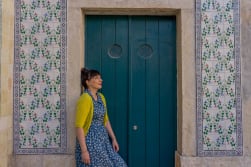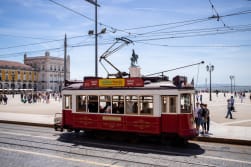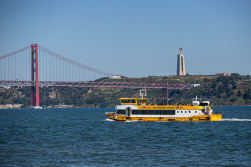Best churches in Lisbon
Places of worship that have stood for centuries and reflect the culture and spirituality of a people, churches are also true monuments of rich heritage to be visited. We're going to talk about some of the city's icons, but there are many more to discover.
Lisbon Cathedral
Built in the 12th century after the reconquest of Lisbon by the 1st Portuguese king D. Afonso Henriques, initially in Romanesque style, its volumetry is graced by Gothic elements, highlighting a beautiful rose window on the façade.
Initially intended as a place of prayer and refuge in case of invasions by the Tagus River, its fortress-like air holds relics and tombs, and the spirit of past centuries lives on in the atmosphere you discover when you pass through the entrance.
Lisbon Cathedral is one of the points of interest of our Hills Tramcar Tour.

São Domingos church
This medieval church dates back to the 13th century, but it has had a long history over the centuries and has been the main setting for various national and royal events. It underwent major renovations, largely motivated by the 1755 earthquake and the 1959 fire for which it is so well known and visited today - the sculptures disfigured by the heat are impressive - also impressive is a wooden image of Jesus Christ which, the story goes, resisted the flames of the fire and can be seen in perfect condition.
It is close to Praça da Figueira, the departure point for both our bus tours - Belém and Modern Lisbon Bus Tour.

St Anthony's Church
This is where the world-famous "Saint Anthony of Padua" was born - so called because his tomb is in this Italian city.
The church was built there, and a crypt in the saint's birthplace, which can also be visited. The church dates back to the 18th century, but 300 years earlier there was already a chapel there. Saint Anthony, a great preacher to whom many miracles are popularly attributed, is also known as the matchmaker saint and one of the patron saints of Lisbon.
In the church you can also leave a little note written to St. Anthony with the miracles you want to ask him for.

Jerónimos Church
One of the most fascinating moments in Portuguese history, the Discoveries, is faithfully portrayed in this imposing 16th-century church belonging to the monastery of the Jerónimos friars.
The intersecting vaults, the light coming through the colorful stained glass windows, the sculptures of saints and kings and all the mystical symbolism linked to the Discoveries make up the Manueline style, a style that uniquely enriches this Gothic structure. Of particular note are the cenotaphs of Camões, the epic poet of the Discoveries and our national hero, and the famous navigator Vasco da Gama, in the church's lower choir.
The Jerónimos Monastery is a stop on our Belém Lisbon Bus Tour.

Estrela Basilica
Built in the 18th century, the baroque and neo-classical style predominates here.
Linked to a promise by Queen Maria I that she would build this church if she had a male child, the church houses the queen's tomb and a beautiful altarpiece painted by Maria I and her sister, Maria Benedita. In addition, here we find one of the remarkable Baroque nativity scenes, this one by the artist Machado de Castro.
The Estrela Basilica, as well as the Estrela Garden, are stops on our Belém Lisbon Bus Tour.

As well as finding some of the main churches along our tours, with free access to the Carris tramcars you can discover many more. Have a good visit!









